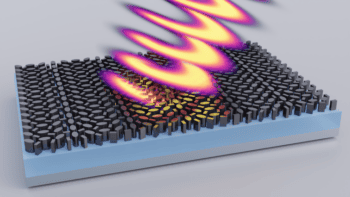
Physicists in Russia and Switzerland have built the smallest optical frequency comb to date, fitting the entire device into a volume of just 1 cm³. Their research is a significant step towards cheap, easily-produced microcombs – which would be suitable for applications including information processing and telecommunications.
An optical frequency comb is a laser that produces a spectrum of discrete, equally-spaced frequency lines – resembling teeth in a comb. In recent years, they have played important roles in metrology, spectroscopy and communications.
One of the most successful methods for creating the combs’ signature spectra is to couple a continuous wave laser to a microresonator waveguide. These microresonators are ideal for producing the so-called “dissipative Kerr Soliton states” – waves that retain their shapes as they travel. This method, however, still has high loss rates, driving up the power requirements of the devices. This means the driving lasers are large and expensive; making low-cost, portable frequency combs unfeasible.
Minimizing losses
Now, a team led by Tobias Kippenberg at the Swiss Federal Institute of Technology Lausanne has found a way to get around this problem. The team used a highly-sophisticated deposition process to fabricate an ultralow-loss silicon nitride microresonator. They then coupled the microresonator to a chip-based indium phosphide laser diode – a compact device that is widely available commercially.
Intrinsic scattering from the microresonator waveguide reflects a small portion of the laser light back to the laser. This feedback helps to stabilize the laser, eliminating any need for bulky on-chip tuning mechanisms such as electronics and heaters.
Occupying 1 cm³, the team’s frequency comb is the smallest ever produced; allowing it to be integrated onto a single chip and controlled electrically. This was mostly possible because the optical losses sustained by the device’s integrated silicon nitride waveguide were unprecedentedly low, meaning power thresholds were low enough to excite dissipative Kerr soliton states. The device consumes less than 1 W and the spacing between the comb’s teeth is less than 100 GHz.
Kippenberg and his colleagues are confident that such a device could allow for next-generation applications including precise distance measurements using LIDAR, as well as facilitating extremely fast information processing in data centres.
Full results are published in Nature Communications.



